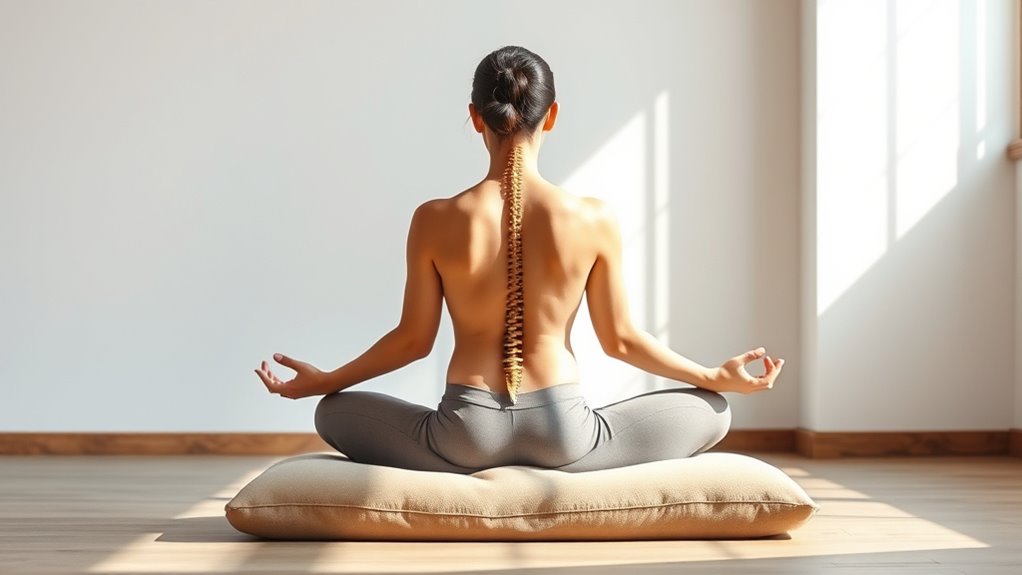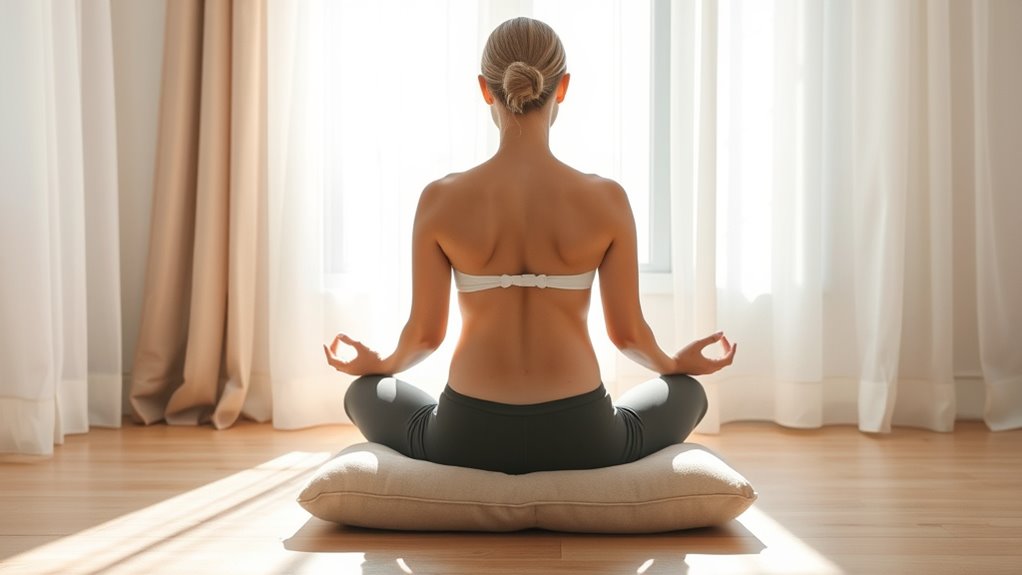Many meditation posture myths, like needing a perfect cross-legged sit or a rigid straight back, aren’t true. Comfort and support matter more than strict alignment, and your body type influences what works best. You don’t have to force your body into a difficult position—finding a supported, relaxed posture promotes better focus and long-term practice. By understanding these real alignment tips, you’ll discover ways to sit comfortably while deepening your mindfulness practices.
Key Takeaways
- Proper meditation posture is personalized; rigid standards are myths; comfort and natural alignment are more important.
- Rigid, perfect postures are unnecessary; support and adjustments promote comfort and sustained practice.
- Maintaining a completely straight back is a misconception; slight relaxation aids breathing and relaxation.
- Traditional cross-legged sitting isn’t mandatory; chairs, kneeling, or reclining positions can also support effective meditation.
- Comfort and ease in posture enhance mental focus and reduce distractions, surpassing the importance of “ideal” alignment.
Common Misconceptions About Sitting Postures

Many people believe there is a single “correct” sitting posture for meditation, but this isn’t true. The truth is, your posture should support your breathing techniques and mental focus, not conform to an idealized image. While sitting comfortably helps you relax and settle into meditation, rigid positions can hinder your practice. Instead, focus on maintaining a straight spine, which allows for smooth breathing and keeps your mind alert. Your shoulders should be relaxed, and your head aligned with your spine. Remember, meditation is about cultivating awareness, and that’s easier when your posture promotes ease and stability. Don’t get caught up in perfection; find a position that feels natural and sustainable for you. Additionally, an aligned posture can contribute to better emotional regulation and mental clarity during your practice.
The Myth of the Perfect Cross-Legged Position

Many believe you need extreme flexibility to sit perfectly cross-legged, but that’s not true. Your comfort is more important than following a traditional ideal. Focus on feeling relaxed rather than achieving a “perfect” posture. Prioritizing proper posture and comfort can help prevent discomfort or injury during meditation.
Flexibility Isn’t Mandatory
Is it necessary to sit perfectly cross-legged to meditate effectively? Not at all. Flexibility isn’t mandatory for a successful practice. You can meditate comfortably in various positions that support breath awareness and mental focus. Here’s a visual to help you imagine different options:
| Position | Description |
|---|---|
| Seated on a chair | Feet flat, back straight, relaxed |
| Kneeling | Cushions under knees, upright |
| Reclined | Back supported, relaxed muscles |
Focus on maintaining a stable, alert posture that encourages deep breathing. Remember, comfort allows you to stay present longer, rather than forcing a position that causes tension. Your goal is to cultivate mindfulness, not perfect alignment. Flexibility isn’t a barrier—your posture and breath awareness matter most.
Comfort Over Tradition
Although the traditional image of meditation often shows practitioners sitting cross-legged on a cushion, insisting on this position as the only effective way can be misleading. Comfort should take priority, as it directly impacts your ability to maintain mindful breathing and mental focus. Forcing yourself into an uncomfortable posture can lead to distraction or physical pain, undermining your practice. Instead, find a position that supports relaxed shoulders, an upright spine, and ease in your muscles. Whether sitting on a chair, using cushions, or lying down, prioritize comfort without sacrificing alignment. When your body feels supported, it’s easier to stay present, deepen your mindful breathing, and sustain mental focus. Remember, effective meditation is about comfort and ease, not adhering to outdated ideals. Recognizing that WWE Raw’s financial impact demonstrates how prioritizing core strengths over traditional measures can lead to greater success, similarly, comfort in your posture allows for a more sustainable and effective meditation practice.
Why a Straight Back Isn’t Always Necessary

Have you ever felt pressured to keep your back perfectly straight during meditation? It’s a common misconception that a straight back is essential for effective practice. In reality, your comfort and natural posture matter more. When your back is too rigid, it can hinder relaxation and breathing techniques, making it harder to maintain mental focus. A slight forward or relaxed posture can still support deep breathing and a calm mind. The goal is to find a position that allows your body to be at ease, so your mind can settle without distraction. Remember, the key isn’t perfection but presence. Your posture should serve your meditation, not restrict it. Flexibility in your approach can lead to deeper, more meaningful practice.
The Role of Comfort and Support in Alignment

How can comfort and support influence your meditation alignment? When you prioritize ergonomic support, you help maintain a natural, relaxed posture without strain. This support keeps your spine aligned and prevents tension buildup, allowing you to stay present longer. Emotional comfort is equally important; feeling safe and relaxed reduces distractions and promotes a deeper meditative state. Using cushions or supportive chairs can ease pressure on your hips and lower back, making it easier to sustain proper alignment. Remember, comfort isn’t about collapsing into a slouch but about finding a position that supports your body’s natural curves. When your body feels supported and emotionally at ease, your meditation becomes more effective, stable, and sustainable. Additionally, incorporating mindful awareness of how your body feels can help you make adjustments that enhance comfort and alignment during your practice.
How Body Type Influences Your Meditation Posture

Your body type plays a big role in finding a comfortable meditation posture. Some positions may feel more natural or stable depending on your build, so adjustments might be necessary. By understanding these differences, you can tailor your practice for better comfort and focus. Considering behavior management strategies can also help address any challenges that arise during meditation sessions.
Posture Variations by Body Type
Body type markedly influences the most comfortable and effective meditation posture for each individual. Your body symmetry and postural flexibility determine which positions feel natural and sustainable. If you have balanced symmetry, you may find sitting cross-legged or seated on a cushion easier, as your joints align well. Those with less flexibility might prefer supported postures, like sitting on a chair or using props. Conversely, individuals with greater flexibility can explore more varied positions, including full lotus or kneeling postures. Recognizing your body’s unique traits helps you avoid strain and find comfort. Environmental considerations such as choosing a suitable location and maintaining proper ventilation can also enhance your practice.
- Symmetrical body types often favor traditional cross-legged poses
- Limited flexibility benefits from supportive props or seated on a chair
- Asymmetry may require adjustments to maintain balance and comfort
- Flexibility allows for more diverse, stable postures
Adapting for Comfort
Adapting your meditation posture to suit your body type guarantees greater comfort and sustainability. To achieve this, focus on ergonomic adjustments that support your natural alignment, reducing strain and fatigue. Posture customization is key—you might need to modify sitting height, cushion thickness, or leg position to feel balanced. For example, if you have tight hips, using a supportive cushion can help you sit comfortably without forcing your body into an unnatural pose. Pay attention to your body’s signals and make small tweaks as needed. These adjustments promote better circulation and encourage longer, more consistent meditation sessions. Incorporating ergonomic adjustments into your practice ensures that your posture supports both comfort and longevity. Remember, comfort isn’t about adhering to a rigid ideal but about creating a supportive posture tailored to your unique body.
Building a Sustainable Practice Without Forcing Your Body

To build a sustainable meditation practice, it’s essential to listen to your physical limits and avoid pushing yourself into discomfort. Respect your body’s signals and prioritize gradual progress. Focus on integrating healthy habits, like proper breathing techniques, to enhance your mental focus without strain. Remember, consistent practice matters more than intensity. Using gentle stretches to ease tension and prevent stiffness, adjusting your posture as needed to stay comfortable during sessions, incorporating mindful breathing to deepen relaxation and clarity, and taking breaks if discomfort arises—never forcing your body into a fixed position—are all essential steps toward a balanced practice.
Frequently Asked Questions
How Can I Improve My Posture Without Feeling Restricted?
To improve your posture without feeling restricted, focus on gentle adjustments and mindful awareness. Use breathing techniques to stay relaxed and centered, which helps reduce tension. Keep your mental focus on maintaining a comfortable, upright position without strain. Incorporate small stretches or movements if needed, and listen to your body’s signals. This mindful approach allows you to improve posture naturally, promoting comfort and better alignment during meditation.
Are There Specific Postures for Different Meditation Styles?
You might wonder if different meditation styles require specific postures. While some styles, like Zazen, favor seated cross-legged positions, others, like walking meditation, focus on movement. Meditation posture varies, but comfort and alignment matter most. Style-specific poses help deepen your practice, yet you can adapt postures to suit your body. Ultimately, choose a position that supports alertness and relaxation, blending your style with your body’s needs.
What Are Signs of Poor Alignment During Meditation?
If you’re experiencing poor alignment during meditation, you might notice discomfort or strain, which can hinder your breathing techniques and mental focus. Signs include a tense neck, slumped shoulders, or a slouched back that makes breathing shallow. These issues make it harder to stay present and focused. To improve, adjust your posture, keep your spine straight, and relax your shoulders. Proper alignment supports better breathing and enhances your meditation experience.
How Do Age and Flexibility Impact Meditation Posture Choices?
Age-related flexibility can influence your meditation posture choices, making certain positions uncomfortable or unsustainable. You might need to adapt your posture to stay comfortable and maintain focus. Posture adaptation is key; for example, sitting on a chair or using cushions can help if tight hips or back pain limit your flexibility. Listen to your body and choose a position that supports your practice without causing strain or discomfort.
Can Posture Adjustments Prevent Meditation-Related Discomfort?
You can prevent meditation-related discomfort by making simple posture adjustments based on your needs. Proper meditation ergonomics guarantees you stay comfortable and alert, reducing strain. Avoid posture myths that suggest one perfect position; instead, find what works for your body. Adjust your sitting height, back support, and leg placement as needed. These tweaks help you stay relaxed and focused, making meditation more enjoyable and sustainable.
Conclusion
Remember, there’s no one-size-fits-all posture for meditation—over 70% of practitioners find comfort in their unique alignment. Embracing your body’s natural shape helps you stay consistent and free from discomfort. Ditch the myths of perfect positions and focus on what truly feels supportive. By honoring your body’s needs, you create a sustainable practice that grows with you, making meditation a truly personal and calming experience every time you sit down.









